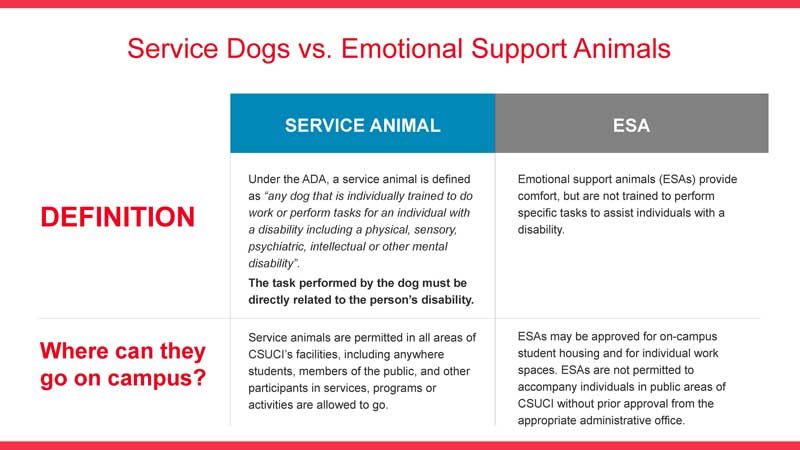Emotional Support Animal (ESA) FAQs
What is an Emotional Support Animal (ESA)?
An emotional support animal is a companion animal that provides therapeutic benefit to an individual with a mental or psychiatric disability. The person seeking the emotional support animal must have a verifiable disability (the reason cannot just be a need for companionship). The animal is viewed as a "reasonable accommodation" under the Fair Housing Amendments Act of 1988 (FHA or FHAct) to those housing communities that have a "no pets" rule. In other words, just as a wheelchair provides a person with a physical limitation the equal opportunity to use and enjoy a dwelling, an emotional support animal provides a person with a mental or psychiatric disability the same opportunity to live independently. Most times, an emotional support animal will be seen as a reasonable accommodation for a person with such a disability.
What is the difference between an ESA and a service animal?
Service animals are defined as dogs or miniature horses that are individually trained to do work or perform tasks for people with disabilities. These tasks can include things like pulling a wheelchair, guiding a person who is visually impaired, alerting a person who is having a seizure, or even calming a person who suffers from Post-Traumatic Stress Disorder. The tasks a service dog can perform are not limited to this list. However, the work or task a service dog does must be directly related to the person's disability. Service dogs may accompany persons with disabilities into places that the public normally goes. This includes state and local government buildings, businesses open to the public, public transportation, food-service facilities and non-profit organizations open to the public. The law that allows a trained service dog to accompany a person with a disability is the Americans with Disabilities Act (ADA).
An emotional support animal (ESA) is an animal (typically a dog or cat though this can include other species) that provides a therapeutic benefit to its owner through companionship. The animal provides emotional support to help mitigate symptoms of a psychiatric disability or other mental impairment. An ESA is not specifically trained to perform tasks for a person who suffers from emotional disabilities.
Where are ESAs permitted on campus?
Unlike a service animal, an emotional support animal is not granted access to places of public accommodation, including food-service facilities. ESAs are not allowed in classrooms or non-residential buildings without prior approval. ESAs should not be brought to campus prior to a CSUCI employee or student obtaining approval from the appropriate administrative office.
A service or emotional support animal can be asked to leave or not allowed participation on campus if:
- The animal is found by the University to be out of control or disruptive and the animal’s owner does not take immediate and effective action to control it
- The animal is not tethered/leashed and/or is roaming freely
- The animal is not housebroken (defecates or urinates without proper disposal in unauthorized area)
- The animal is found to be neglected or mistreated and prompt corrective action is not taken
- The animal is physically ill
I am a student and I do not live in on-campus student housing. Am I allowed to have an ESA on campus?
If a student is in need of an accommodation relating to an emotional support animal outside of student housing, the student must contact the Disability Accommodations and Support Services (DASS) office.
I am a staff/faculty member who wants to have an ESA? Who do I contact?
University employees may be permitted to bring their emotional support animal into University buildings where they are employed. An employee requesting an emotional support animal as a reasonable accommodation in the workplace is treated the same as any other request for reasonable accommodation in the workplace. An employee who wishes to bring an emotional support animal to the workplace must contact Human Resources which may require documentation for an accommodation.

